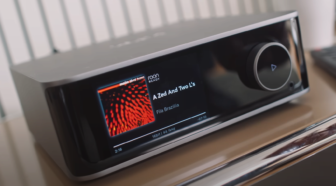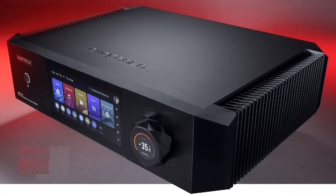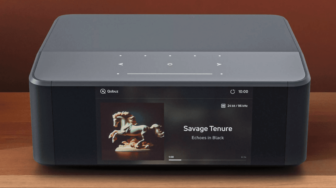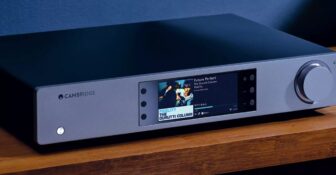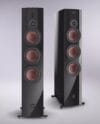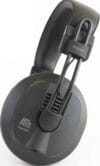Bluesound Node N132 Review
The well-known Bluesound Node has received a discreet upgrade that adds good things to the whole – without the price going up.
by JOHN ALEX HVIDLYKKE

Bluesound, which is a sister company to NAD, is primarily known for its streaming receiver, Node. The name is easy to remember since all versions have been called Bluesound Node. In the latest generation, however, it has become a bit more complicated, as there is now also a stripped-down version called Node Nano and a luxury version called Node Icon. This test, however, concerns the standard model, Bluesound Node with the model code N132.
The Bluesound Node N132 is exactly like its predecessor. The well-known “lunchbox” in black or white plastic has exactly the same dimensions and weight as before. And there are no marks or stickers proclaiming that we are dealing with an improved version. One has to read the datasheet carefully to see what the difference is between the two product generations.
First, the digital converter has been replaced with the fairly well-regarded ESS Sabre 9039. This is not surprising, as the ESS DACs I have heard so far have been really good-sounding. Incidentally, this is the same DAC that sits in the Node Nano, which we tested recently, and in the more expensive anniversary model Node X.
NOW WITH ROOM CORRECTION
Secondly, the Bluesound Node N132 now gets room correction. Just like with NAD, the choice has fallen on Dirac Live. This is a really interesting and useful improvement, and extra relevant for those who use the Node as a digital preamplifier in combination with a power amplifier or a pair of active speakers.
However, we had no opportunity to test the room correction in the Bluesound Node since it is not ready yet but will come as an update. However, we have encountered it in several other products, and it has worked flawlessly. The version that comes to the Bluesound Node N132 is the limited Live version that can only be used up to 500 Hz. On the other hand, that is the frequency range where it is most needed.
Dirac Live will only come to Node N132 and Node Icon. The older versions of Node will not get it.
The exterior of the new Node is, as mentioned, unchanged. This means that the front of the small plastic box only has a headphone jack and that the control is done on a touch panel on the top, where you can control the volume. There are also five presets that can be programmed with internet radio stations or playlists. Unfortunately, there is no display. If you want to see what you’re doing, you have to step up to the top model Node Icon.
WASN’T THERE ROOM FOR TWO INPUTS?
On the back are the same inputs and outputs as before: A combined input with a 3.5 mm connector accommodates both analog minijack and optical digital. It’s smart but a bit impractical, which is emphasized by the fact that it has been necessary to include an optical TOSLink adapter plug in the box. It should have been possible to find space for both a 3.5 mm analog input and a regular optical input on the back.
An HDMI input with eARC makes it possible to connect the TV and use the Node as a digital preamplifier. A USB A port can be used for external storage media for music files. The Node reads all imaginable formats, and soon it will also be able to play DSD files.
On the output side, there is analog stereo out. In the app, you can choose whether the output level should be variable or fixed. Two other RCA connectors are for subwoofer and coaxial digital output, respectively. Finally, there is an optical TOSLink output as well as a trigger output and an input for infrared remote control extension. Unfortunately, the remote control is not included in the box; it must be purchased separately.
SOUND QUALITY
Since the Bluesound Node N132 has both an analog output and two digital outputs, it is possible to use it both as an independent music player and as a pure digital audio source via the amplifier’s DAC—or, for that matter, as an expensive external DAC.
Since this is the most likely scenario in the price range, we have primarily evaluated the Node N132 via the analog output as a digital signal source. It was connected to my NAD C 658 preamplifier (which also has a built-in BlueOS module) as a more expensive reference. But we also listened to it as a pure digital audio source via the NAD’s built-in DAC. The differences were small.
Bluesound paints a very good picture of the room and the acoustic scene. The old model (Node N130) placed the music in front of the speakers, but with the Node N132 there is a pleasant sense of space and depth. Not as deep and precisely drawn as via the DAC in the more expensive NAD preamp, and the air in the room is not as clear. But considering the price, it’s good. Just like on the Node Nano (which after all has the same DAC and analog section), the sound from the analog output on the Bluesound is, on the other hand, a bit more fun than from the stiff NAD.
COMPETITORS
When the previous Bluesound Node version came out, HD-quality streaming reception was not common. It is today, when all manufacturers—including Sonos—can play virtually all conceivable file types and resolutions.
Today, every streamer in the budget-friendly class must endure being compared to WiiM, which in recent years has set a new standard for what one can expect for the money. Even though the Bluesound Node has not gone up in price, the WiiM Ultra is still a quarter cheaper and can boast a nice color touchscreen. Both have room correction, but it gives bonus points that you get excellent Dirac Live with Bluesound.
When you purchase through links on our site, I may earn an affiliate commission. Here’s how it works.






